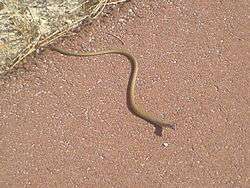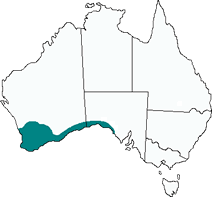Dugite
| Dugite | |
|---|---|
 | |
| A dugite on a walking path | |
| Scientific classification | |
| Kingdom: | Animalia |
| Phylum: | Chordata |
| Subphylum: | Vertebrata |
| Class: | Reptilia |
| Order: | Squamata |
| Suborder: | Serpentes |
| Family: | Elapidae |
| Genus: | Pseudonaja |
| Species: | P. affinis |
| Binomial name | |
| Pseudonaja affinis Günther, 1872 | |
| subspecies | |
The dugite /ˈdjuːɡaɪt/ (Pseudonaja affinis) is a species of venomous, potentially lethal, snake native to Western Australia, a member of the family Elapidae.
The local Nyungar name for the dugite is dobitj.
Description
Dugites are venomous snake, so are seen as dangerous. The dugite is coloured grey, green, or brown. The colours vary widely between individuals and are an unreliable means of identifying the species. Black scales can be scattered over the body; their scales are relatively large with a semi-glossy appearance. The most distinguishing characteristic is the head that can be rather small and indistinct from the neck. A dugite's body is long and slender in build and can grow up to 2 m (6 ft 7 in) in total length (including tail), but the average size is roughly 1.5 metres.
Distribution and habitat

P. affinis is found in southern parts of Western Australia and in remote coastal parts of western South Australia. As can be seen on the map , the Dugite is found between southern parts of Western Australia and in coastal parts of western South Australia.
The Dugite occupies a wide variety of habitats ranging from coastal dunes, heathlands, shrub lands to woodlands. The Dugite also appears to thrive in heavily degraded habitats such as golf courses, industrial areas, and open agricultural farmlands.
The Dugite is one species of snake that has increased in population since the opening up of its natural habitats andintroduction of the house mouse due to the mouse being a main food source for the Dugite. In the Perth metropolitan area, the Dugite is one of the most common snakes found next to buildings. In areas of human population the snake will take temporary shelter under things such as concrete slabs, fibro sheeting and roofing tin, although in more natural habitats they will shelter under rocks and in abandoned termite mounds. They are also a snake species that burrows during the winter period.
Behaviour
In the wild they may be sheltering beneath logs or rocks. When disturbed, Dugites are very shy and will often slither away, however they will defend themselves if cornered. The species is diurnal. On hot days, activity occurs mainly in the morning, and to lesser extent in the afternoon.
Reproduction
As with all brown snakes, mating normally occurs between early September and late November. The Dugite is an egg laying (oviparous) snake, and will typically deposit around 30 eggs and abandon them to self-incubate. The eggs will hatch after approximately 65 days. Under optimal environmental conditions the Dugite has been known to lay two clutches during the same season
Envenomation
The venom of P. affinis is potentially one of the most lethal in the world, causing coagulopathic and procoagulant effects.[1] Dugites generally avoid biting humans, but risks of encounters rise when they are most active during the mating season through October and November.[2]
The last death attributed to a dugite was in 1993 after an elderly woman died in Spearwood.[2]
In January 2011, a seven-year-old Perth boy was bitten and temporarily paralyzed after a dugite entered his bedroom and wrapped itself around his arm while he slept. After receiving immediate medical attention, he made a full recovery.
Taxonomy
The species was first described by Albert Günther in 1872.[3] It is a member of the genus Pseudonaja, sometimes referred to as brown snakes, contained in the Elapidae family.[4] The descriptions of three subspecies are currently accepted; they are:[5]
- Pseudonaja affinis affinis Günther, 1872
- Pseudonaja affinis exilis Storr, 1989[6]
- Pseudonaja affinis tanneri (Worrell, 1961)[7]
Note: A trinomial authority in parentheses indicates that the subspecies was originally described in a genus other than Pseudonaja.
Conservation status
Dugites are protected under the Wildlife Conservation Act 1950 and to kill or injure one attracts a fine of up to A$4000.[8]
See also
- The Dugites - 1970s Perth band
References
- ↑ Judge RK, Henry PJ, d'Aprile AC, Lynch D, Jelinek G, Wilce MCJ, Wilce JA. 2002. Identification of PLA2 and alpha-Neurotoxin Proteins in the Venom of Pseudonaja affinis (Dugite). Toxicology and Applied Pharmacology 181 (3): 184-191. (Publisher: Academic Press).
- 1 2 Dugites love to live near people ABC, 10 August 2004. Cached by Google.
- ↑ Günther A. 1872. Seventh Account of new Species of Snakes in the Collection of the British Museum. Ann. Mag. Nat. Hist., Fourth Series 9: 13-37 + Plates III-VI. (Pseudonaja affinis, new species, pp. 35-36 + Plate IV, Figure C).
- ↑ "Pseudonaja affinis". Integrated Taxonomic Information System.
- ↑ Pseudonaja affinis at the Reptarium.cz Reptile Database.
- ↑ Storr GM. 1979. Dangerous Snakes of Western Australia, Third Edition. Perth: Western Australian Museum Press. 24 pp.
- ↑ Worrell E. 1961. A New Insular Brown Snake. Proceedings of the Royal Zoological Society of New South Wales 79: 56-58, Figures A-C. (Demansia nuchalis tanneri, new subspecies).
- ↑ Dramatic increase in snake attacks on pets Narelle Towie, PerthNow, 2007-11-26. Retrieved 2008-03-13.
Judge, R. K., Henry, P. J., d'Aprile, A. C., Lynch, D., Jelinek, G. A., Wilce, M. C. J., & Wilce, J. A. (2002). Identification of PLA(2) and alpha-neurotoxin proteins in the venom of pseudonaja affinis (dugite). Toxicology and Applied Pharmacology, 181(3), 184.
Herrmann, R. P., Davey, M. G., & Skidmore, P. H. (1972). The coagulation defect after envenomation by the bite of the dugite (demansia nuchalis affinis), a western australian brown snake. The Medical Journal of Australia, 2(4), 183.
Wagovau. (2016). Wagovau. Retrieved 13 May 2016, from http://perthzoo.wa.gov.au/wp-content/uploads/2011/06/Dugite-Fact-Sheet.pdf
Australianmuseumnetau. (2016). Australianmuseumnetau. Retrieved 13 May 2016, from http://australianmuseum.net.au/dugite
Pilbarapythonscom. (2016). Pilbarapythonscom. Retrieved 13 May 2016, from http://www.pilbarapythons.com/dugite.htm
Animalarkcomau. (2016). Animalarkcomau. Retrieved 13 May 2016, from http://www.animalark.com.au/pdfs/SnakeAware.pdf
Further reading
- Bush, Brian et al. 2007. Reptiles and Frogs in the Bush: Southwestern Australia. Crawley, Western Australia: University of Western Australia Press. 302 pp. ISBN 978-1-920694-74-6.
- Storr GM. 1979. (Reprinted 1988). Dangerous Snakes of Western Australia. Perth, W.A.: Western Australian Museum. 24 pp. ISBN 0724479759.
- Storr GM. 1989. A new Pseudonaja (Serpentes: Elapidae) from Western Australia. Records of the Western Australian Museum 14 (3): 421-423. (Pseudonaja affinis exilis, new subspecies).
- Storr GM. 2002. Snakes of Western Australia: Revised Edition Perth, W.A.: Western Australian Museum. 309 pp. ISBN 0-7307-1295-8.
- Swan, Gerry. 1995. A Photographic Guide to Snakes and Other Reptiles of Australia Frenchs Forest, New South Wales: New Holland Publishers. 144 pp. ISBN 1-85368-585-2.
External links
| Wikimedia Commons has media related to Pseudonaja affinis. |
| Wikispecies has information related to: Pseudonaja affinis |